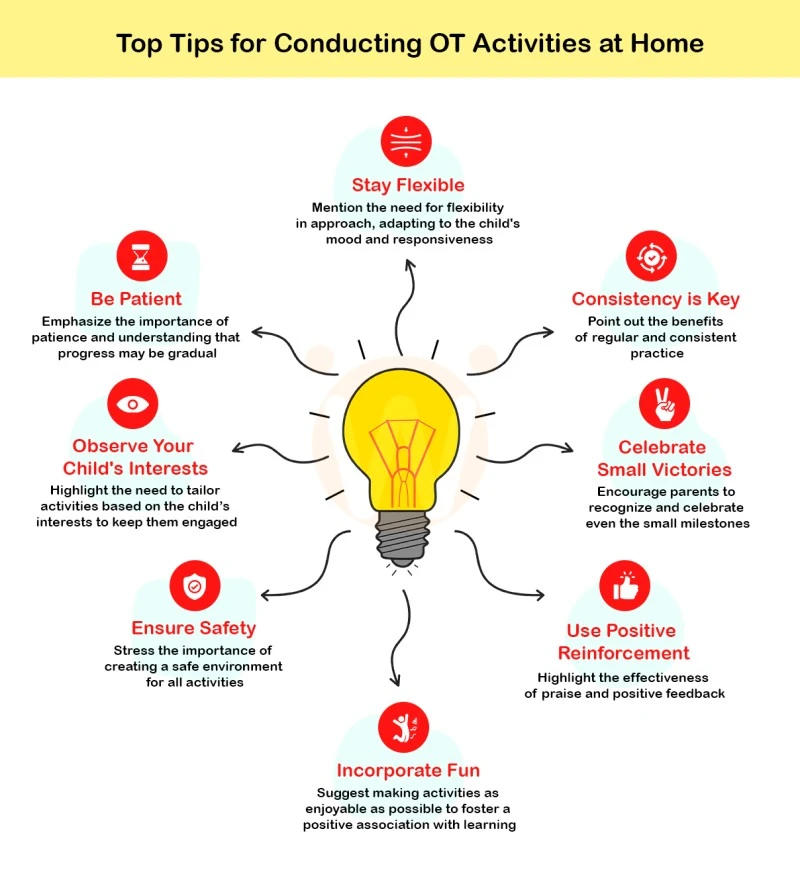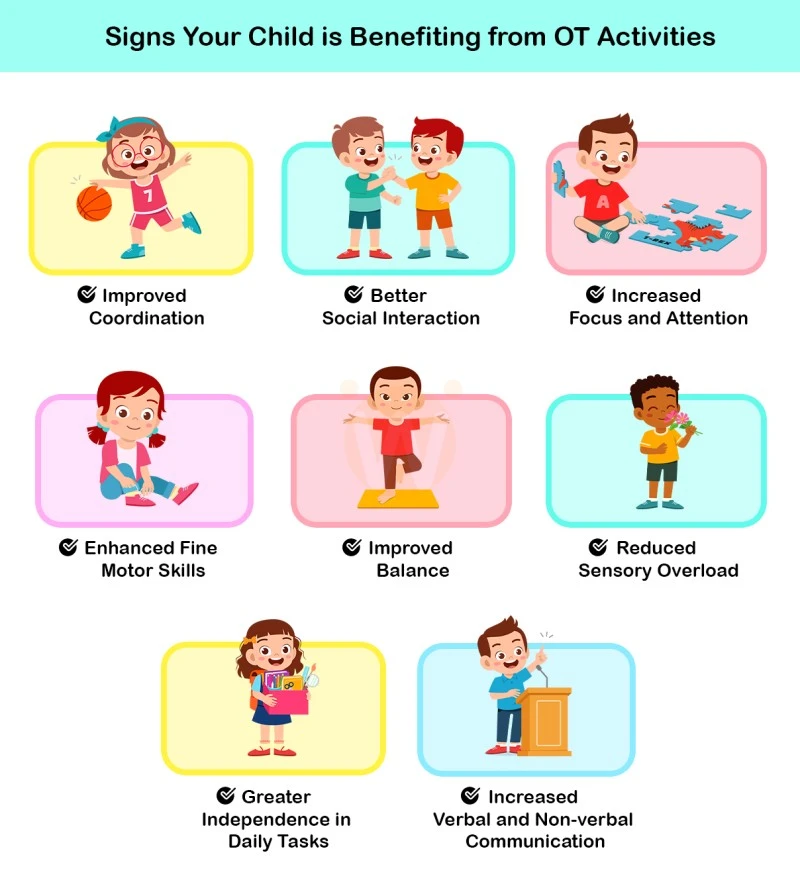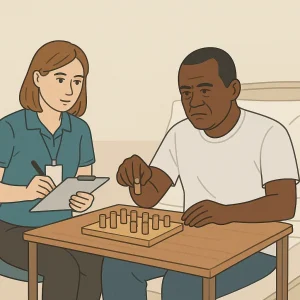Engaging Home-Based Occupational Therapy Activities for Children with Autism
By Prapoorna M
Last Updated: October 24, 2024
Occupational therapy (OT) is a kind of support that helps individuals, especially children, to master essential life skills. This therapy is particularly vital for children with autism, a condition that affects how a person communicates and relates to the world around them. Children with autism may face challenges in social interaction, sensory processing, and motor skills. Occupational therapy steps in to address these areas, helping them to navigate daily life more effectively.
For children on the autism spectrum, Occupational therapy focuses on boosting their ability to perform everyday tasks. This could mean improving fine motor skills (like holding a pencil or using scissors), enhancing gross motor skills (like running and jumping), or developing social skills (like taking turns in a game). The therapy also supports sensory integration, which is crucial for children who might be over-sensitive or under-sensitive to sensory stimuli like light, sound, or touch.
The beauty of occupational therapy lies in its personalized approach. It’s not a one-size-fits-all method. Instead, it’s tailored to meet each child’s unique needs and help them reach their full potential in all areas of life – from playing and learning to eating and dressing.
For more information on how occupational therapy supports children with autism, visit our detailed guide.
Activity Categorization
| Activity Name | Skill Development | Recommended Age |
|---|---|---|
| Climbing Stairs and Wedges | Gross Motor Skills, Coordination | 3-6 years |
| Jumping on Number Mats | Balance, Body Awareness | 4-7 years |
| Puzzle Assembling | Fine Motor Skills, Problem-Solving | 3+ years |
| Finger Painting | Sensory Processing, Creativity | 2-5 years |
| Sock Matching Game | Cognitive Development, Categorization | 3-6 years |
| Gardening Together | Responsibility, Gross Motor Skills | 4+ years |
| Dress-Up Games | Fine Motor Skills (Zipping, Buttoning) | 3-8 years |
| Obstacle Courses | Spatial Awareness, Gross Motor Skills | 4-10 years |
| Interactive Video Games | Coordination, Cognitive Skills | 5+ years |
| Simple Yoga Poses | Stress Relief, Body Awareness | 3-8 years |
Now, let’s talk about the role of home-based occupational therapy activities. These are activities that parents or caregivers can do with their children at home to complement the structured therapy sessions they might receive from a professional. The home environment offers a comfortable and familiar setting for the child, which can be very reassuring and can make learning new skills less stressful.
Incorporating Occupational Therapy activities at home has several benefits:
Reinforces Skills: It allows children to practice and reinforce the skills they learn in therapy sessions, which can accelerate their progress.
Builds Routine: It helps establish a routine, providing the child with a sense of stability and predictability.
Involves the Family: It gives family members a chance to be actively involved in the child’s development, strengthening bonds and understanding.
Tailors to Interests: Parents can design activities based on what their child enjoys, making therapy more engaging and effective.
Enhances Real-world Application: It allows children to apply their skills in real-life situations, enhancing their independence and confidence.
In short, occupational therapy, particularly when extended into the home, can be a powerful tool in supporting the development of children with autism. It helps them gain essential life skills, feel more confident in their abilities, and navigate the world around them with greater ease.
1. Proprioceptive Activities
Proprioceptive activities are key in helping children with autism develop a better sense of their body in space, which is crucial for coordination and balance. These activities can be both fun and therapeutic, and they’re easy to incorporate into daily routines at home. Here’s a look at some effective proprioceptive activities:
Climbing Stairs and Wedges
- What It Involves: Encouraging your child to climb stairs or use specially designed wedges and ramps.
- Benefits: This activity is great for building muscle strength and enhancing coordination. It helps the child understand how to control their movements, especially in activities involving height and depth.
- How to Do It: Start with small steps or low wedges and gradually increase the height as your child becomes more confident.
Also read: 10 Exciting Occupational Therapy Activities Kids Will Love
Jumping on Number Mats
- What It Involves: Using number mats or simple floor markings for jumping games.
- Benefits: Jumping on number mats enhances body awareness and balance. It’s a playful way to teach spatial orientation and numeracy skills.
- How to Do It: Call out numbers and have your child jump to the corresponding mat. Make it a fun game by adding music or playful challenges.
Wheelbarrow Walking
- What It Involves: Holding your child’s legs while they walk on their hands, similar to how one handles a wheelbarrow.
- Benefits: This activity strengthens the upper body and improves coordination. It also enhances the child’s ability to plan and execute movements.
- How to Do It: Ensure your child is comfortable and safe. Hold their legs at a height that is challenging yet achievable for them, and walk them forward for a short distance.
Animal Walks and Crawling
- What It Involves: Imitating different animal walks, like bear walks, crab walks, or crawling like a cat.
- Benefits: These playful activities encourage imaginative play and develop motor skills. They help in muscle development and body awareness.
- How to Do It: Demonstrate the animal walks and encourage your child to imitate them. You can make it more engaging by creating a story around it or setting up an ‘animal race’.
Each of these activities not only aids in physical development but also brings an element of fun and creativity to your child’s daily routine. They are simple to set up and can be a joyful bonding experience for you and your child.
2. Balance and Coordination
Balance and coordination are vital skills that help children with autism in daily activities and overall motor development. Here are some engaging and easy activities that can be done at home to improve these skills:
Walking on Lines
- What It Involves: Creating lines on the floor using tape, ropes, or even chalk if you’re outdoors. The child is then encouraged to walk along these lines.
- Benefits: This simple activity significantly improves balance. It helps the child learn how to control and coordinate their body movements, especially in a linear path.
- How to Do It: Make straight, curved, or zigzag lines. Encourage your child to walk along these lines without stepping off. You can make it more challenging and fun by adding music or timing them.
Jumping Over Obstacles
- What It Involves: Setting up safe, low obstacles in a row for the child to jump over. These can be cushions, soft toys, or small boxes.
- Benefits: Jumping over obstacles is an enjoyable way to enhance coordination and gross motor skills. It also helps in developing timing and rhythm in movements.
- How to Do It: Place the obstacles in a row and demonstrate how to jump over them. Encourage your child to follow. Ensure the obstacles are safe and won’t cause injury if tripped over.
Balancing on One Leg
- What It Involves: Encouraging your child to stand and maintain balance on one leg for a few seconds, gradually increasing the time.
- Benefits: This activity is excellent for challenging and improving balance. It also promotes focus and concentration, as the child must pay attention to maintain their posture.
- How to Do It: Start by having your child hold onto a chair or your hand for support. Gradually, encourage them to try balancing without support. Make it a game by seeing how long they can hold the pose or by counting together.
Incorporating these activities into your child’s daily routine can make a significant difference in their balance and coordination skills. Always ensure safety and provide encouragement and support to make these activities a positive and confidence-building experience.
3. Body Awareness Activities
Body awareness is a key developmental area for children with autism, helping them understand their body’s position and movement in space. Here are some activities to enhance body awareness:
Simple Instruction Games
- What It Involves: Games that include following simple instructions, such as clapping hands, touching ears, or stomping feet.
- Benefits: These activities improve body awareness by helping children become more conscious of different parts of their body and how they move.
- How to Do It: Start with basic commands like “Touch your nose” or “Clap your hands.” Gradually, combine actions like “Jump and then touch your ears.” Make it fun by turning it into a Simon Says game.
Mirror Exercises
- What It Involves: Using a full-length mirror to help children observe and mimic their movements.
- Benefits: Mirror exercises aid in developing a better understanding of body movements and positions. They can also enhance visual perception and self-recognition.
- How to Do It: Stand with your child in front of a mirror. Perform simple movements like raising hands or making faces and ask your child to mimic them. Discuss the movements to encourage awareness.
4. Vestibular Activities
Vestibular activities stimulate the part of the inner ear that helps regulate balance and spatial orientation. These activities are particularly beneficial for children with autism to improve their sense of motion and balance.
Trampoline Activities
- What It Involves: Using a trampoline for controlled jumping activities.
- Benefits: Safe jumping on a trampoline can significantly improve balance and is an excellent way for a child to experience different movements. It also provides sensory input which can be calming for some children.
- How to Do It: Ensure safety by using a trampoline with a net and supervise closely. Start with gentle bouncing and gradually move to higher jumps. You can incorporate counting or rhymes to make it more engaging.
Swinging
- What It Involves: Using a swing to provide movement experiences.
- Benefits: Swinging is a therapeutic activity that enhances the sense of motion and balance. The rhythmic motion can be soothing and help regulate sensory processing.
- How to Do It: Use a secure and comfortable swing. Start with gentle pushing and let the child guide the desired height and speed of swinging. Always ensure safety and supervise closely.
Both body awareness and vestibular activities are not just beneficial for developmental needs but are also fun and can be a source of joy and relaxation for children with autism.
5. Tactile Activities
Tactile activities are essential for children with autism as they help in sensory integration, particularly in getting accustomed to various textures and touch sensations. Here are a couple of tactile activities that can be both enjoyable and beneficial:
Textured Mat Walks
- What It Involves: Walking on mats or surfaces with different textures like grass, carpet, bubble wrap, or fabric.
- Benefits: These walks expose children to a variety of tactile experiences, which is crucial for sensory processing. It helps in desensitizing any discomfort related to different textures.
- How to Do It: Lay out different textured materials on the floor and encourage your child to walk barefoot on them. Talk about how each texture feels under their feet to enhance sensory recognition and language skills.
Finger Painting
- What It Involves: Using finger paints to create art.
- Benefits: Finger painting is a fantastic sensory activity that allows children to experience different textures and temperatures. It stimulates the tactile senses and encourages creativity.
- How to Do It: Provide non-toxic, washable finger paints and large sheets of paper. Let your child use their fingers and hands to paint, encouraging free expression. You can also incorporate tools like sponges or brushes for varied textures.
Understand how fine motor activities lay the foundation for writing with our article on Pre-writing Skills in Children.
6. Fine Motor Skills Training
Fine motor skills are crucial for tasks like writing, buttoning, and using utensils. Here are activities that can help improve these skills:
Puzzle Assembling
- What It Involves: Completing jigsaw puzzles.
- Benefits: Puzzle assembling enhances hand-eye coordination and problem-solving skills. It also improves focus and concentration.
- How to Do It: Choose puzzles appropriate for your child’s age and skill level. Start with large pieces and simple designs, gradually moving to more complex puzzles as they improve.
Clipping Clothespins
- What It Involves: Using clothespins to pick up objects or attach them to a line or edge.
- Benefits: This activity strengthens the small muscles in the fingers and hands, which are essential for tasks like writing, tying shoelaces, or buttoning shirts.
- How to Do It: Provide a basket of clothespins and a line or edge to clip them onto. You can turn this into a game by timing how fast they can clip and unclip the pins or by sorting colored pins.
Both tactile activities and fine motor skills training are not only crucial for developmental progress but can also be sources of fun and creativity for children with autism. When introducing these activities, it’s important to consider the child’s sensory preferences and gradually introduce new textures or complex tasks to ensure a positive experience.
Explore our guide on occupational therapy for toddler delays for additional support in fine motor skills development.
7. Creative and Sensory-Engaging Crafts
Creative crafts are a wonderful way to engage children with autism, helping them to fine-tune their motor skills while also offering sensory stimulation. Here are some craft ideas that are both fun and therapeutic:
Making Edible Necklaces
- What It Involves: Creating necklaces using string and edible items like cereal or pasta.
- Benefits: This activity helps in developing fine motor skills as children thread the items onto the string. It’s also a playful way to explore textures and shapes.
- How to Do It: Provide your child with a sturdy string and edible items with holes, like ring-shaped cereals or tube-shaped pasta. Demonstrate how to thread these onto the string and encourage them to make their own necklace. This also provides an opportunity for a snack once the activity is done!
Sticker Art
- What It Involves: Using stickers to create different designs and patterns on paper or other surfaces.
- Benefits: Sticker art is excellent for enhancing creativity and fine motor precision. Peeling and placing stickers also improve dexterity and hand-eye coordination.
- How to Do It: Give your child a variety of stickers and a blank sheet of paper. Encourage them to create a scene or a pattern. For added fun, they can even decorate household items like storage boxes or notebooks.
For a comprehensive understanding of sensory integration, check out our occupational therapy guide.
8. Fun with Everyday Items
Everyday household items can be transformed into engaging tools for developmental activities. Here’s how you can use common items for fun and learning:
Sock Matching Game
- What It Involves: Matching pairs of socks.
- Benefits: This simple game helps in developing categorization and recognition skills. It also enhances visual perceptual skills and attention to detail.
- How to Do It: Mix up several pairs of socks and lay them out. Ask your child to find and match each pair. For an added challenge, use socks with similar patterns or colors.
Container Filling
- What It Involves: Transferring water or sand from one container to another.
- Benefits: This activity is great for developing hand coordination and understanding the concept of volume and measurement.
- How to Do It: Set up two containers and provide a tool like a small cup or a spoon. Have your child transfer water or sand from one container to the other. You can make it more educational by discussing concepts like ‘more’, ‘less’, or ‘equal’.
In both creative crafts and using everyday items for fun activities, the goal is to engage the child in a playful manner while subtly working on their developmental skills. These activities provide a comfortable and low-pressure environment for children with autism to learn and explore at their own pace.
9. Household Contribution Activities
Incorporating household activities into the daily routine of children with autism not only contributes to their sense of responsibility but also enhances various developmental skills. Here are some ways to involve them in household tasks:
Helping in the Kitchen
- What It Involves: Assisting with simple kitchen tasks like mixing ingredients, spreading butter, or cutting soft foods with a safe knife.
- Benefits: Cooking activities are excellent for improving fine motor skills, following instructions, and understanding sequences. It also offers sensory experiences through different textures and temperatures.
- How to Do It: Choose simple and safe recipes that your child can participate in. Tasks like pouring, stirring, and spreading are good starting points. Always ensure safety in the kitchen, especially when handling sharp tools or hot surfaces.
Gardening Together
- What It Involves: Engaging in gardening tasks such as watering plants, digging soil, or planting seeds.
- Benefits: Gardening is a great way to develop motor skills and learn about responsibility and the natural world. It can also be a calming sensory experience, offering various textures and smells.
- How to Do It: Assign your child simple tasks in the garden. They could help with watering plants, digging small holes for planting, or even picking vegetables or flowers. Use this opportunity to talk about nature, growth, and caring for the environment.
10. Therapeutic Play
Play is a fundamental way through which children learn and develop. For children with autism, therapeutic play can be structured to enhance specific skills:
Dress-Up Games
- What It Involves: Playing with costumes or dressing up dolls.
- Benefits: Dress-up games are perfect for practicing fine motor skills like zipping, buttoning, and tying. They also encourage imagination and role-playing.
- How to Do It: Provide a selection of clothes with different fastenings and encourage your child to dress up dolls or themselves. Make it a fun activity by creating stories around the characters they dress up as.
Pretend Play
- What It Involves: Engaging in imaginative play scenarios, such as playing house, school, or store.
- Benefits: Pretend play fosters creativity, social skills, and language development. It allows children to practice real-life scenarios in a safe and controlled environment.
- How to Do It: Use toys or everyday objects to create play scenarios. Encourage your child to take on different roles, like a teacher, a storekeeper, or a doctor. Join in the play to model social interactions and dialogue.
Both household contribution activities and therapeutic play are valuable in enhancing life skills and developmental competencies in children with autism. These activities not only aid in skill development but also offer opportunities for bonding and fun, making them an integral part of a child’s daily routine.
11. Learning Through Movement
Movement-based activities are not only enjoyable but also crucial for the development of gross motor skills and spatial awareness in children with autism. Here are some engaging ways to incorporate learning through movement:
Obstacle Courses
- What It Involves: Creating a course at home or in the garden with various obstacles like cushions, boxes, and ropes.
- Benefits: Navigating through an obstacle course enhances gross motor skills, improves spatial awareness, and boosts problem-solving abilities. It also helps in understanding instructions and sequences.
- How to Do It: Use safe household items to set up a simple course. The course can include activities like crawling under a rope, stepping over cushions, or walking along a taped line. Ensure safety by supervising and using soft, non-hazardous materials.
Explore the importance of movement in reaching Motor & Sensory Milestones in pediatric therapy.
Dance and Movement Therapy
- What It Involves: Encouraging your child to move and dance to music.
- Benefits: Dancing offers a joyful way to develop rhythmic movement and coordination. It can also be a form of expression and a source of sensory stimulation.
- How to Do It: Play various types of music and dance with your child. Use ribbons or scarves to add a sensory element to the dance. Follow their lead or teach them simple dance moves to mimic.
12. Technology-Aided Activities
In the digital age, technology can be a valuable tool in supporting the development of children with autism. Here are some tech-based activities that can be both educational and fun:
Interactive Video Games
- What It Involves: Playing video games that require physical interaction, like dance games or sports simulations.
- Benefits: These games promote engagement, coordination, and motor planning. They can also enhance cognitive skills like problem-solving and decision-making.
- How to Do It: Choose age-appropriate and ability-appropriate video games that encourage movement. Ensure the games are fun and not overly complex or frustrating.
Educational Apps
- What It Involves: Using apps like Autism BASICS and Speech BASICS designed for learning new skills, practicing language, or enhancing motor coordination.
- Benefits: Educational apps can be a fun way to reinforce learning and practice motor skills. They often offer a personalized and interactive learning experience.
- How to Do It: Select apps that are suited to your child’s developmental level and interests. Look for apps that offer a sensory-friendly experience and are not overly stimulating.
In both movement-based activities and technology-aided learning, the key is to find a balance that suits your child’s needs and preferences. These activities should be sources of fun and learning, helping your child to develop essential skills in an engaging and enjoyable way.
Explore the benefits of online speech therapy for children with autism.
13. Relaxation Techniques
Relaxation techniques are crucial for children with autism to help them manage stress and improve their overall well-being. Here are some methods that can be easily practiced at home:
Simple Yoga Poses
- What It Involves: Introducing your child to basic yoga poses that are easy to follow and enjoyable.
- Benefits: Yoga is excellent for stress relief and enhancing body awareness. It can also improve flexibility, balance, and strength.
- How to Do It: Start with simple poses like the tree pose, cat-cow stretch, or butterfly pose. Use visuals or follow along videos to make it easier for your child to understand and mimic the poses. Keep the sessions short and fun to maintain their interest.
Breathing Exercises
- What It Involves: Teaching your child different breathing techniques to help them relax and focus.
- Benefits: Breathing exercises are effective in promoting self-regulation and calming. They can be particularly helpful during moments of overwhelm or sensory overload.
- How to Do It: Practice simple breathing techniques like deep belly breathing or balloon breathing. You can use visuals like blowing bubbles or balloons to make the exercise more engaging and understandable for your child.
14. Community Involvement
Engaging with the community is important for the social development of children with autism. It provides opportunities for them to interact with others and learn new skills in different settings:
Local Park Visits
- What It Involves: Regular visits to a nearby park or playground.
- Benefits: Park visits offer a chance for outdoor play, which is essential for physical health. They also provide opportunities for social interaction and exposure to different environments.
- How to Do It: Plan regular visits to a local park. Encourage your child to explore different play equipment and interact with other children, if they are comfortable doing so. You can also use this time to practice social skills in a natural setting.
Group Classes
- What It Involves: Enrolling your child in group classes such as music, art, or sports.
- Benefits: Group classes provide a structured environment for learning new skills and socializing with peers. They also help in building confidence and improving communication skills.
- How to Do It: Choose classes based on your child’s interests and strengths. Start with small groups or classes specifically designed for children with autism to ensure a supportive and understanding environment.
Incorporating relaxation techniques and community involvement into the routine of children with autism not only aids in their development but also enhances their quality of life. These activities provide a balanced approach to learning and relaxation, essential for their overall growth and well-being.
Read about our initiatives in different locations for community-based support.
Parental Tips and Tricks

For parents of children with autism, engaging them in therapeutic activities at home can be both rewarding and challenging. Here are some tips and tricks to make these activities more therapeutic and tailored to your child’s unique needs and preferences:
Understanding Your Child’s Preferences
- Observe and Learn: Pay close attention to what interests and calms your child. Incorporate these elements into the activities.
- Be Flexible: Be ready to adapt activities based on your child’s mood and response on any given day.
- Create a Routine: Children with autism often thrive on routine. Try to schedule activities at consistent times.
- Keep it Fun: Remember, the primary goal is to engage your child in a fun and stress-free manner. If an activity isn’t working, it’s okay to move on to something else.
- Safety First: Always consider the safety of the activities, especially when using small objects or working in different environments.
Making Activities Therapeutic
- Set Clear Goals: Determine what you want each activity to achieve, whether it’s improving fine motor skills, enhancing social interaction, or providing sensory input.
- Incorporate Learning: Turn activities into opportunities for learning, such as counting during a jumping game or identifying colors during a painting activity.
- Use Praise and Encouragement: Positive reinforcement can greatly motivate your child.
- Gradual Progression: Start with simple tasks and gradually increase the complexity as your child becomes more comfortable and skilled.
- Incorporate Sensory Elements: Many children with autism have specific sensory preferences. Tailor activities to include their preferred sensory inputs.
For more guidance on parenting autistic children, visit our dedicated section.
Weekly Activity Planner
| Day of the Week | Morning Activity | Afternoon Activity |
|---|---|---|
| Monday | Obstacle Courses | Puzzle Assembling |
| Tuesday | Climbing Stairs and Wedges | Finger Painting |
| Wednesday | Jumping on Number Mats | Sock Matching Game |
| Thursday | Animal Walks and Crawling | Gardening Together |
| Friday | Wheelbarrow Walking | Dress-Up Games |
| Saturday | Dance and Movement Therapy | Making Edible Necklaces |
| Sunday | Local Park Visits | Simple Yoga Poses |
For more activity ideas, visit our extensive list of home-based occupational therapy activities.
Additional Activity List
Here’s a list of 30 additional simple, home-based occupational therapy activities:
- Building with LEGO blocks.
- Making homemade playdough.
- Sorting colored beads.
- Playing with water in a sensory bin.
- Creating a collage with magazine cutouts.
- Assembling and decorating a cardboard box fort.
- Playing simple board games.
- Burying and finding objects in a sandbox.
- Making a sensory bottle with glitter and oil.
- Practicing zipping and unzipping large bags.
- Drawing shapes in shaving cream.
- Tossing bean bags into a basket.
- Blowing bubbles and popping them.
- Stringing large beads onto shoelaces.
- Playing Simon Says to encourage body awareness.
- Creating shadow figures with a flashlight.
- Watering indoor plants.
- Preparing simple snacks like sandwiches.
- Sorting laundry by color or type.
- Playing hopscotch drawn with chalk.
- Pasting stickers onto paper to form patterns.
- Doing simple jigsaw puzzles.
- Creating a DIY obstacle course with pillows and chairs.
- Playing catch with a soft ball.
- Cutting out shapes from colored paper.
- Baking and decorating cookies.
- Having a picnic in the living room or garden.
- Drawing or painting a family portrait.
- Singing and dancing to favorite songs.
- Playing with magnetic letters on the fridge.
Each of these activities can be modified to suit your child’s abilities and interests, ensuring they are both engaging and beneficial for their development. Remember, the key to successful home-based therapy is patience, creativity, and a lot of love.
Find more engaging activities for your child.
Conclusion
As we’ve explored throughout this guide, engaging in home-based occupational therapy activities is vital for the holistic development of children with autism. These activities are not just about skill-building; they are pathways to greater independence, confidence, and joy in daily life. Each activity, from simple tactile games to more structured tasks like cooking or gardening, plays a significant role in nurturing various skills in your child. They cater to improving fine and gross motor skills, enhancing sensory processing, boosting social interaction, and providing valuable life lessons in a nurturing home environment.

For parents and caregivers, consistency and patience are key. Every child is unique, and progress might look different from one child to another. It’s important to celebrate small victories and remain patient through the challenges. Remember, the goal is to create a supportive and loving environment where your child feels encouraged to explore, learn, and grow at their own pace.
At Wellness Hub, we understand the journey parents of children with special needs go through. Our commitment is to provide support, guidance, and resources to make this journey smoother and more fulfilling. We believe in a holistic approach to development, where every child is given the opportunity to reach their fullest potential. For more tailored advice, resources, or support, do not hesitate to visit the Wellness Hub website. Our team of experts is dedicated to helping you and your child navigate the path of development with the utmost care and expertise. At Wellness Hub, we are more than a resource; we are a community committed to nurturing the well-being and potential of every child with special needs. Together, we can create a world where every child thrives.
For further support and personalized advice, visit Wellness Hub’s contact page.
Frequently Asked Questions:
1.What are occupational therapy activities?
Occupational therapy (OT) activities are tasks and exercises designed to help individuals develop, recover, or maintain the daily living and work skills of people with physical, mental, or developmental conditions. For children with autism, these activities are tailored to improve their cognitive, sensory, motor, and social skills.
2. How often should my child engage in these activities?
The frequency can vary based on your child’s needs and abilities. However, incorporating small activities into daily routines can be very effective. Consistency is key, so try to include short, manageable activities regularly rather than longer, less frequent sessions.
3. Can these activities be done at home without professional guidance?
Yes, many Occupational therapy activities can be safely done at home. However, it’s important to consult with an occupational therapist initially to understand your child’s specific needs and to get guidance on how to effectively carry out these activities.
4. How can I tell if the activities are helping my child?
Look for small signs of progress, such as improvements in fine motor skills, better coordination, increased interest in interaction, or greater ease in performing daily tasks. Remember, progress can be gradual and varies from child to child.
5. Are there any risks associated with home-based Occupational therapy activities?
If done correctly and under suitable guidance, these activities are generally safe. Always ensure that the environment is safe for the activity you’re conducting and that materials used are appropriate for your child’s age and developmental level.
6. How can I keep my child engaged in these activities?
Choose activities based on your child’s interests and preferences. Keep the sessions fun and interactive. It’s also helpful to involve siblings or other family members in the activities.
7. Can these activities be adapted as my child grows older?
Absolutely. As your child develops, their needs and capabilities will change. It’s important to adapt activities to suit their evolving skills and interests. Regular consultations with an occupational therapist can provide new ideas and adjustments.
8. How can I balance occupational therapy activities with other therapies my child might be receiving?
It’s important to have a holistic approach. Make sure there’s a balance between different therapies, playtime, and rest. A well-structured routine that incorporates different activities and therapies can be beneficial.
9. Where can I find more resources or support for doing these activities at home?
Wellness Hub is an excellent resource for families with children who have special needs. Our website offers a wealth of information, guidance, and support to help you in your journey with occupational therapy at home.
10. Can these activities help in reducing behavioral issues in children with autism?
While these activities primarily focus on developmental skills, they can indirectly help in managing certain behavioral issues. Activities that promote self-regulation, focus, and sensory integration can be particularly helpful in reducing stress and improving behavior.
About the Author:
Prapoorna Mangalampalli, Psychologist
Prapoorna, an author with dual master’s degrees in Psychology and English, excels in exploring and enhancing human experiences. Her writing, characterized by deep empathy and insight, primarily focuses on the complexities of counseling, spanning areas such as online, marital, relationship, child, family, and career counseling. Specialized training in various counseling sectors underscores her dedication to positive change. In her blogs, Prapoorna offers valuable guidance and a unique perspective for parents of children with Autism and special needs, creating a supportive community in this realm.
Book your Free Consultation Today
Parent/Caregiver Info:
Client’s Details:
* Error Message








